Soil Erosion and Sediment Load Management Strategies for Sustainable Irrigation in Arid Regions
Abstract
1. Introduction
2. Materials and Methods
2.1. The Study Area
2.2. Data and Methods
2.2.1. Annual Sediment Yield in Gomal River
2.2.2. Assessment of Erosion Rates
Rainfall-Runoff Erosivity Factor R
Soil Erodibility Factor K
Topographic Factor (LS)
Crop Management Factor C and Conservation Support Practice Factor P
2.3. Sediment Transport Modeling
3. Results and Discussion
3.1. Annual Sediment Yield
3.2. Erosion Rate Estimation
3.3. Scenario Testing in Revised Universal Soil Loss Equation (RUSLE)
3.4. Sediment Transport in a Settling Reservoir
4. Conclusions
Author Contributions
Funding
Institutional Review Board Statement
Informed Consent Statement
Data Availability Statement
Acknowledgments
Conflicts of Interest
Notation
| a | organic matter content (%) |
| A | average annual soil loss |
| b | code related to soil structure |
| c | code related to soil permeability |
| C | crop management factor |
| K | soil erodibility factor |
| LS | topographic factor |
| M | percent silt and very fine sand contents |
| MFI | modified frontier index |
| NDVI | normalized difference vegetation index |
| NIR | near infra-red |
| p | annual rainfall |
| P | conservation support practice factor |
| pi | monthly rainfall |
| R | rainfall-runoff erosivity factor |
| U | upslope contributing area per unit width |
| l | constant in Equation (6) |
| m | exponent in Equation (5) representing sheet erosion |
| mclay | clay fraction content (<0.002 mm); |
| msilt | silt fraction content (0.002–0.05 mm); |
| mvfs | very fine sand fraction content (0.05–0.1 mm) |
| n | exponent in Equation (5) representing rill erosion |
| r | constant in Equation (6) |
| β | slope |
| L0 | length of the unit plot |
| S0 | slope of unit plot |
References
- Renard, K.; Foster, G.; Weesies, G.; McCool, D.; Yoder, D. Predicting Soil Erosion by Water: A Guide to Conservation Planning with the Revised Universal Soil Loss Equation (RUSLE); United States Government Printing: Washington, DC, USA, 1997.
- Boardman, J.; Poesen, J. Soil Erosion in Europe: Major Processes, Causes and Consequences. In Soil Erosion in Europe; John Wiley & Sons, Ltd.: Hoboken, NJ, USA, 2006; pp. 477–487. ISBN 978-0-470-85920-9. [Google Scholar]
- Zokaib, S.; Naser, G. Impacts of Land Uses on Runoff and Soil Erosion A Case Study in Hilkot Watershed Pakistan. Int. J. Sediment Res. 2011, 26, 343–352. [Google Scholar] [CrossRef]
- National Research Council. Soil and Water Quality: An Agenda for Agriculture; National Academies Press: Washington, DC, USA, 1993; p. 2132. ISBN 978-0-309-04933-7. [Google Scholar]
- Borrelli, P.; Robinson, D.A.; Fleischer, L.R.; Lugato, E.; Ballabio, C.; Alewell, C.; Meusburger, K.; Modugno, S.; Schütt, B.; Ferro, V.; et al. An Assessment of the Global Impact of 21st Century Land Use Change on Soil Erosion. Nat. Commun. 2017, 8, 2013. [Google Scholar] [CrossRef]
- Munir, S. Role of Sediment Transport in Operation and Maintenance of Supply and Demand Based Irrigation Canals: Application to Machai Maira Branch Canals. Ph.D. Thesis, UNESCO-IHE Institute for Water Education, Delft, The Netherlands, January 2011. [Google Scholar]
- Sarwar, M.K.; Anjum, M.N.; Mahmood, S. Impact of Silt Excluder on Sediment Management of an Irrigation Canal: A Case Study of D.G. Khan Canal, Pakistan. Arab. J. Sci. Eng. 2013, 38, 3301–3307. [Google Scholar] [CrossRef]
- Allahyonesi, H.; Omid, M.H.; Haghiabi, A.H. A Study of the Effects of the Longitudinal Arrangement Sediment Behavior near Intake Structures. J. Hydraul. Res. 2008, 46, 814–819. [Google Scholar] [CrossRef]
- Atkinson, E. Vortex-Tube Sediment Extractors. I: Trapping Efficiency. J. Hydraul. Eng. 1994, 120, 1110–1125. [Google Scholar] [CrossRef]
- Melone, A.M. Canals and Waterways, Sediment Control. In General Geology; Springer: Boston, MA, USA, 1988; pp. 55–63. ISBN 978-0-387-30844-9. [Google Scholar]
- Jones, K.R.; Berney, O.; Carr, D.P.; Barrett, E.C. Arid Zone Hydrology for Agricultural Development; FAO Irrigation and Drainage Paper 37; Food and Agriculture Organization of the United Nations: Rome, Italy, 1981; ISBN 92-5-101079-X. [Google Scholar]
- Chang, T.J.; Zhou, H.; Guan, Y. Applications of Erosion Hotspots for Watershed Investigation in the Appalachian Hills of the United States. J. Irrig. Drain Eng. 2016, 142, 4015057. [Google Scholar] [CrossRef]
- Pham, T.G.; Degener, J.; Kappas, M. Integrated Universal Soil Loss Equation (USLE) and Geographical Information System (GIS) for Soil Erosion Estimation in A Sap Basin: Central Vietnam. Int. Soil Water Conserv. Res. 2018, 6, 99–110. [Google Scholar] [CrossRef]
- Hussain, F.; Nabi, G.; Wu, R.-S.; Hussain, B.; Abbas, T. Parameter Evaluation for Soil Erosion Estimation on Small Watersheds Using SWAT Model. Int. J. Agric. Biol. Eng. 2019, 12, 96–108. [Google Scholar] [CrossRef]
- Chuenchum, P.; Xu, M.; Tang, W. Estimation of Soil Erosion and Sediment Yield in the Lancang–Mekong River Using the Modified Revised Universal Soil Loss Equation and GIS Techniques. Water 2019, 12, 135. [Google Scholar] [CrossRef]
- HALCROW. Gomal Zam Irrigation Project-Siltation Rapid Assessment Overview; Halcrow Pakistan (Pvt) Limited: Islamabad, Pakistan, 2017. [Google Scholar]
- Pakistani and, U.S. Experts Conserve Water in Gomal Zam Dam Area. Available online: https://pk.usembassy.gov/pakistani-and-u-s-experts-conserve-water-in-gomal-zam-dam-area/ (accessed on 12 July 2020).
- Wischmeier, W.H.; Smith, D.D. Predicting Rainfall-Erosion Losses from Cropland East of the Rocky Mountains: Guide for Selection of Practices for Soil and Water Conservation; USDA Agriculture Handbooks; Agricultural Research Service, U.S. Department of Agriculture in Cooperation with Purdue Agricultural Experiment Station: Washington, DC, USA, 1965; p. 47.
- Lee, G.-S.; Lee, K.-H. Scaling Effect for Estimating Soil Loss in the RUSLE Model Using Remotely Sensed Geospatial Data in Korea. Hydrol. Earth Syst. Sci. Discuss. 2006, 3, 135–157. [Google Scholar] [CrossRef]
- Panditharathne, D.L.D.; Abeysingha, N.S.; Nirmanee, K.G.S.; Mallawatantri, A. Application of Revised Universal Soil Loss Equation (RUSLE) Model to Assess Soil Erosion in “Kalu Ganga” River Basin in Sri Lanka. Available online: https://www.hindawi.com/journals/aess/2019/4037379/ (accessed on 6 January 2020).
- Ganasri, B.P.; Ramesh, H. Assessment of Soil Erosion by RUSLE Model Using Remote Sensing and GIS—A Case Study of Nethravathi Basin. Geosci. Front. 2016, 7, 953–961. [Google Scholar] [CrossRef]
- Terranova, O.; Antronico, L.; Coscarelli, R.; Iaquinta, P. Soil Erosion Risk Scenarios in the Mediterranean Environment Using RUSLE and GIS: An Application Model for Calabria (Southern Italy). Geomorphology 2009, 112, 228–245. [Google Scholar] [CrossRef]
- Alewell, C.; Borrelli, P.; Meusburger, K.; Panagos, P. Using the USLE: Chances, Challenges and Limitations of Soil Erosion Modelling. Int. Soil Water Conserv. Res. 2019, 7, 203–225. [Google Scholar] [CrossRef]
- Trimble, S.W.; Crosson, P.U.S. Soil Erosion Rates—Myth and Reality. Science 2000, 289, 248–250. [Google Scholar] [CrossRef] [PubMed]
- Benavidez, R.; Jackson, B.; Maxwell, D.; Norton, K. A Review of the (Revised) Universal Soil Loss Equation ((R)USLE): With a View to Increasing Its Global Applicability and Improving Soil Loss Estimates. Hydrol. Earth Syst. Sci. 2018, 22, 6059–6086. [Google Scholar] [CrossRef]
- Morgan, R.P.C. Soil Erosion and Conservation, 3rd ed.; John Wiley & Sons, Inc.: Hoboken, NJ, USA, 2005; ISBN 978-1-4051-4467-4. [Google Scholar]
- Roose, E.J. Erosion et Ruissellement En Afrique de l’Ouest: Vingt Années de Mesures En Petites Parcelles Expérimentales; Laboratoire de Pédologie de l’ORSTOM: Abidjan, Ivory Coast, 1975. [Google Scholar]
- Arnoldus, H.M.J. An Approximation of the Rainfall Factor in the Universal Soil Loss Equation; John Wiley and Sons Ltd: Hoboken, NJ, USA, 1980. [Google Scholar]
- Fernandez, C.; Wu, J.Q.; McCool, D.K.; Stockle, C.O. Estimating Water Erosion and Sediment Yield with GIs, RUSLE, and SEDD. J. Soil Water Conserv. 2003, 58, 128–136. [Google Scholar]
- İrvem, A.; Topaloğlu, F.; Uygur, V. Estimating Spatial Distribution of Soil Loss over Seyhan River Basin in Turkey. J. Hydrol. 2007, 336, 30–37. [Google Scholar] [CrossRef]
- Nakil, M. Analysis of Parameters Causing Water Induced Soil Erosion; Fifth Annual Progress Seminar; Indian Institute of Technology: Bombay, India, 2014; unpublished. [Google Scholar]
- Wischmeier, W.H.; Smith, D.D. Predicting Rainfall Erosion Losses: A Guide to Conservation Planning; Department of Agriculture, Science and Education Administration: Washington, DC, USA, 1978. [Google Scholar]
- Panagos, P.; Meusburger, K.; Ballabio, C.; Borrelli, P.; Alewell, C. Soil Erodibility in Europe: A High-Resolution Dataset Based on LUCAS. Sci. Total Environ. 2014, 479–480, 189–200. [Google Scholar] [CrossRef] [PubMed]
- Ullah, S.; Ali, A.; Iqbal, M.; Javid, M.; Imran, M. Geospatial Assessment of Soil Erosion Intensity and Sediment Yield: A Case Study of Potohar Region, Pakistan. Environ. Earth Sci. 2018, 77, 705. [Google Scholar] [CrossRef]
- Desmet, P.J.J.; Govers, G. A GIS Procedure for Automatically Calculating the USLE LS Factor on Topographically Complex Landscape Units. J. Soil Water Conserv. 1996, 51, 427–433. [Google Scholar]
- Moore, I.D.; Burch, G.J. Physical Basis of the Length-Slope Factor in the Universal Soil Loss Equation 1. Soil Sci. Soc. Am. J. 1986, 50, 1294–1298. [Google Scholar] [CrossRef]
- Wilson, J.P.; Gallant, J.C. (Eds.) Terrain Analysis: Principles and Applications; Wiley: New York, NY, USA, 2000; ISBN 978-0-471-32188-0. [Google Scholar]
- Kinnell, P.I.A. Event Soil Loss, Runoff and the Universal Soil Loss Equation Family of Models: A Review. J. Hydrol. 2010, 385, 384–397. [Google Scholar] [CrossRef]
- Lanorte, A.; Cillis, G.; Calamita, G.; Nolè, G.; Pilogallo, A.; Tucci, B.; De Santis, F. Integrated Approach of RUSLE, GIS and ESA Sentinel-2 Satellite Data for Post-Fire Soil Erosion Assessment in Basilicata Region (Southern Italy). Geomat. Nat. Hazards Risk 2019, 10, 1563–1595. [Google Scholar] [CrossRef]
- Borrelli, P.; Märker, M.; Panagos, P.; Schütt, B. Modeling Soil Erosion and River Sediment Yield for an Intermountain Drainage Basin of the Central Apennines, Italy. CATENA 2014, 114, 45–58. [Google Scholar] [CrossRef]
- Karydas, C.G.; Sekuloska, T.; Silleos, G.N. Quantification and Site-Specification of the Support Practice Factor When Mapping Soil Erosion Risk Associated with Olive Plantations in the Mediterranean Island of Crete. Environ. Monit. Assess. 2009, 149, 19–28. [Google Scholar] [CrossRef]
- Lazzari, M.; Gioia, D.; Piccarreta, M.; Danese, M.; Lanorte, A. Sediment Yield and Erosion Rate Estimation in the Mountain Catchments of the Camastra Artificial Reservoir (Southern Italy): A Comparison between Different Empirical Methods. CATENA 2015, 127, 323–339. [Google Scholar] [CrossRef]
- Vatandaşlar, C.; Yavuz, M. Modeling Cover Management Factor of RUSLE Using Very High-Resolution Satellite Imagery in a Semiarid Watershed. Environ. Earth Sci. 2017, 76, 65. [Google Scholar] [CrossRef]
- Durigon, V.L.; Carvalho, D.F.; Antunes, M.A.H.; Oliveira, P.T.S.; Fernandes, M.M. NDVI Time Series for Monitoring RUSLE Cover Management Factor in a Tropical Watershed. Int. J. Remote Sens. 2014, 35, 441–453. [Google Scholar] [CrossRef]
- Van der Knijff, J.M.; Jones, R.J.A.; Montanarella, L. Soil Erosion Risk Assessment in Europe; European Commission: Brussels, Belgium, 2000. [Google Scholar]
- Ma, H.L.; Wang, Z.L.; Zhou, X. Estimation of Soil Loss Based on RUSLE in Zengcheng, Guangdong Province. Yangtze River 2010, 41, 90–93. [Google Scholar]
- Olsen, N.R.B. SSIIM User’s Manual; The Norwegian University of Science and Technology: Trondheim, Norway, 2018. [Google Scholar]
- Ali, K.F.; De Boer, D.H. Spatial Patterns and Variation of Suspended Sediment Yield in the Upper Indus River Basin, Northern Pakistan. J. Hydrol. 2007, 334, 368–387. [Google Scholar] [CrossRef]
- Ashraf, M.; Bhatti, M.T.; Shakir, A.S.; Tahir, A.A.; Ahmad, A. Sediment Control Interventions and River Flow Dynamics: Impact on Sediment Entry into the Large Canals. Environ. Earth Sci. 2015, 74, 5465–5474. [Google Scholar] [CrossRef]
- Sinha, D.; Joshi, V.U. Application of Universal Soil Loss Equation (USLE) to Recently Reclaimed Badlands along the Adula and Mahalungi Rivers, Pravara Basin, Maharashtra. J. Geol. Soc. India 2012, 80, 341–350. [Google Scholar] [CrossRef]
- Sholagberu, A.T.; Mustafa, M.R.U.; Yusof, K.W.; Ahmad, M.H. Evaluation of rainfall-runoff erosivity factor for Cameron highland, Pahang, Malaysia. J. Ecol. Eng. 2016, 17, 1–8. [Google Scholar] [CrossRef]
- Panagos, P.; Borrelli, P.; Meusburger, K.; Yu, B.; Klik, A.; Jae Lim, K.; Yang, J.E.; Ni, J.; Miao, C.; Chattopadhyay, N.; et al. Global Rainfall Erosivity Assessment Based on High-Temporal Resolution Rainfall Records. Sci. Rep. 2017, 7, 4175. [Google Scholar] [CrossRef] [PubMed]
- Kouli, M.; Soupios, P.; Vallianatos, F. Soil Erosion Prediction Using the Revised Universal Soil Loss Equation (RUSLE) in a GIS Framework, Chania, Northwestern Crete, Greece. Environ. Geol. 2009, 57, 483–497. [Google Scholar] [CrossRef]
- Patriche, C.V.; Pirnau, R.; Grozavu, A.; Rosca, B. A Comparative Analysis of Binary Logistic Regression and Analytical Hierarchy Process for Landslide Susceptibility Assessment in the Dobrov River Basin, Romania. Pedosphere 2016, 26, 335–350. [Google Scholar] [CrossRef]
- Marques, V.S.; Ceddia, M.B.; Antunes, M.A.H.; Carvalho, D.F.; Anache, J.A.A.; Rodrigues, D.B.B.; Oliveira, P.T.S. USLE K-Factor Method Selection for a Tropical Catchment. Sustainability 2019, 11, 1840. [Google Scholar] [CrossRef]
- Tesfaye, G.; Debebe, Y.; Fikirie, K. Soil Erosion Risk Assessment Using GIS Based USLE Model for Soil and Water Conservation Planning in Somodo Watershed, South West Ethiopia. IJOEAR 2018, 4, 9. [Google Scholar]
- Sujatha, E.R.; Sridhar, V. Spatial Prediction of Erosion Risk of a Small Mountainous Watershed Using RUSLE: A Case-Study of the Palar Sub-Watershed in Kodaikanal, South India. Water 2018, 10, 1608. [Google Scholar] [CrossRef]
- Abuzar, M.K.; Shakir, U.; Ashraf, M.A.; Khan, S.; Shaista, S.; Pasha, A.R. GIS Based Risk Modeling of Soil Erosion under Different Scenarios of Land Use Change in Simly Watershed of Pakistan. J. Himal. Earth Sci. 2018, 51, 132–143. [Google Scholar]
- Bashir, S.; Baig, M.A.; Ashraf, M.; Anwar, M.M.; Bhalli, M.N.; Munawar, S. Risk Assessment of Soil Erosion in Rawal Watershed Using Geoinformatics Techniques. Sci.Int. 2013, 25, 583–588. [Google Scholar]
- Koirala, P.; Thakuri, S.; Joshi, S.; Chauhan, R. Estimation of Soil Erosion in Nepal Using a RUSLE Modeling and Geospatial Tool. Geosciences 2019, 9, 147. [Google Scholar] [CrossRef]
- Lencha, B.K.; Moges, A. Identification of Soil Erosion Hotspots in Jimma Zone (Ethiopia) Using GIS Based Approach. Ethiop. J. Environ. Stud. Manag. 2016, 8, 926. [Google Scholar] [CrossRef]
- Panagos, P.; Borrelli, P.; Meusburger, K.; Alewell, C.; Lugato, E.; Montanarella, L. Estimating the Soil Erosion Cover-Management Factor at the European Scale. Land Use Policy 2015, 48, 38–50. [Google Scholar] [CrossRef]
- Butt, M.J.; Mahmood, R.; Waqas, A. Sediments Deposition Due to Soil Erosion in the Watershed Region of Mangla Dam. Environ. Monit. Assess. 2011, 181, 419–429. [Google Scholar] [CrossRef] [PubMed]
- Boix-Fayos, C.; de Vente, J.; Martínez-Mena, M.; Barberá, G.G.; Castillo, V. The Impact of Land Use Change and Check-Dams on Catchment Sediment Yield. Hydrol. Process. 2008, 22, 4922–4935. [Google Scholar] [CrossRef]
- Xiang-Zhou, X.; Hong-Wu, Z.; Ouyang, Z. Development of Check-Dam Systems in Gullies on the Loess Plateau, China. Environ. Sci. Policy 2004, 7, 79–86. [Google Scholar] [CrossRef]
- Castillo, V.M.; Mosch, W.M.; García, C.C.; Barberá, G.G.; Cano, J.A.N.; López-Bermúdez, F. Effectiveness and Geomorphological Impacts of Check Dams for Soil Erosion Control in a Semiarid Mediterranean Catchment: El Cárcavo (Murcia, Spain). CATENA 2007, 70, 416–427. [Google Scholar] [CrossRef]

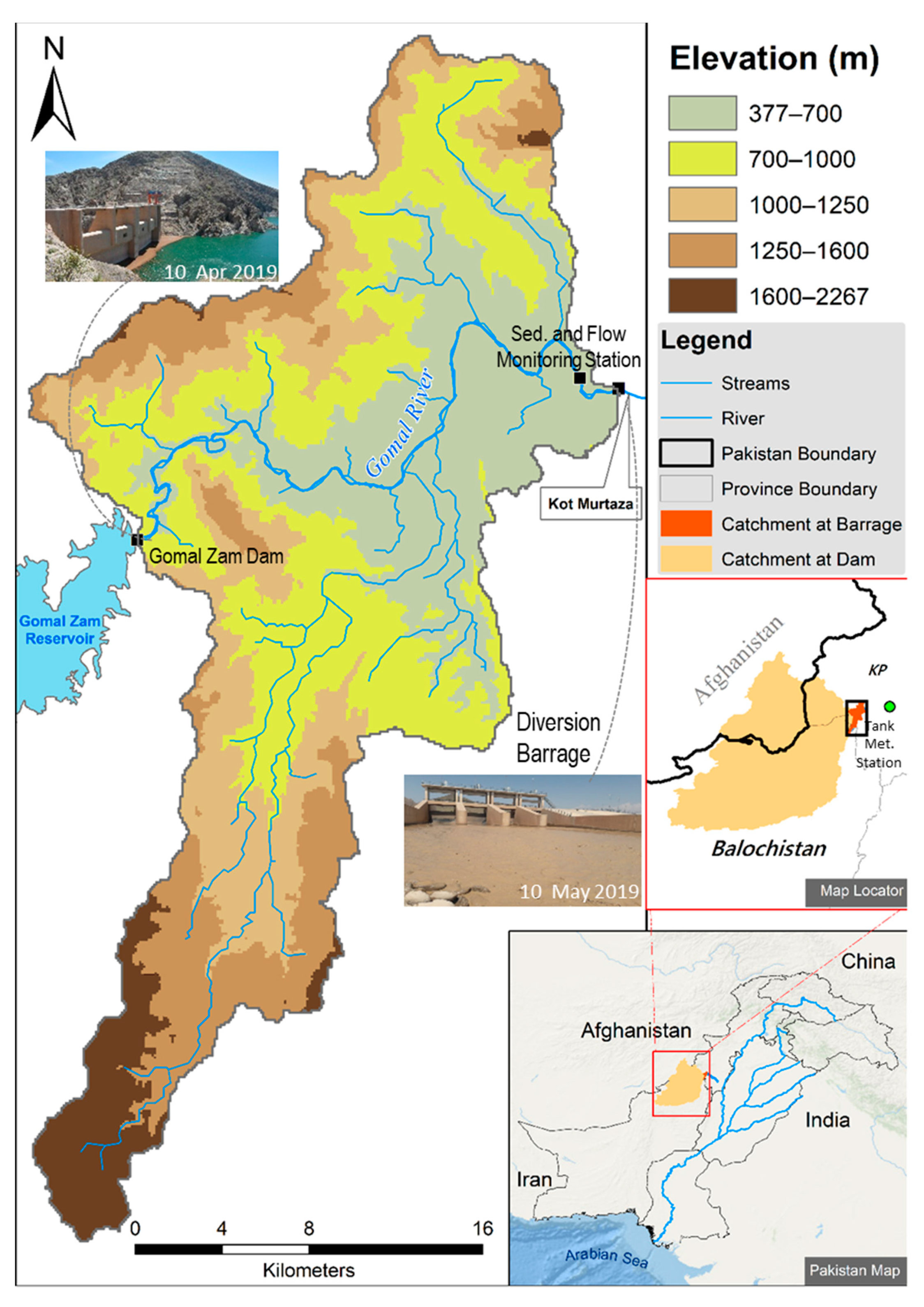
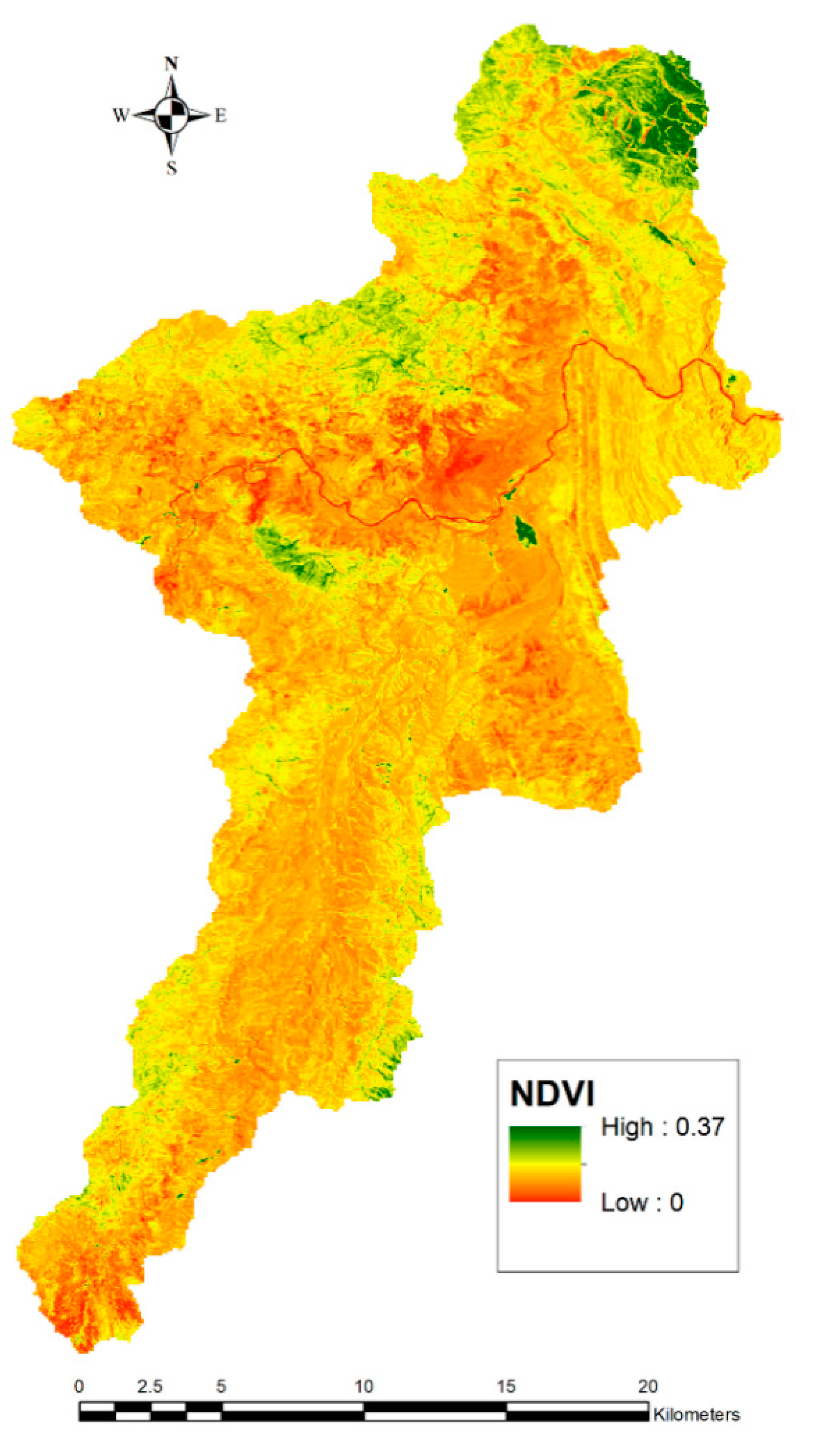
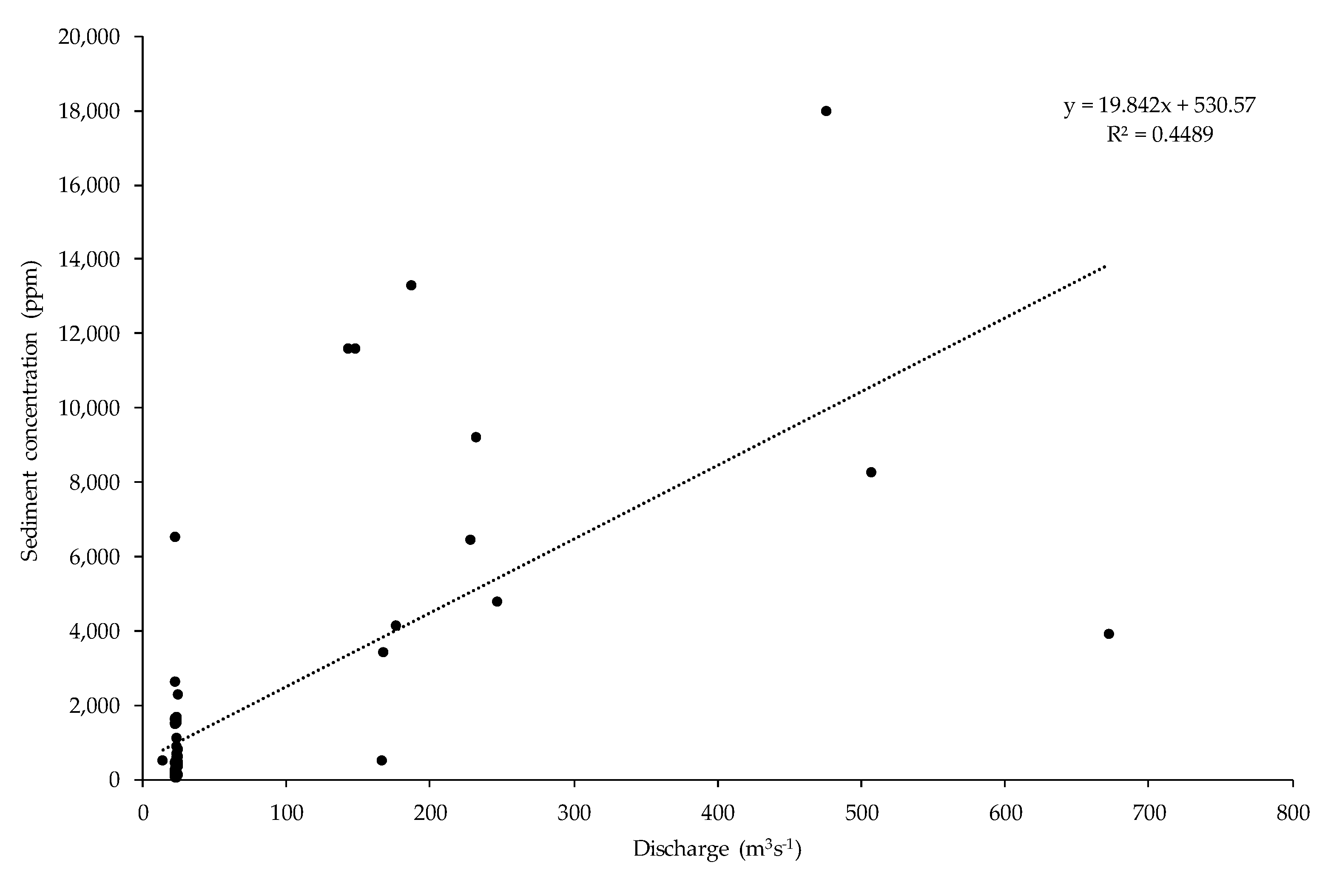
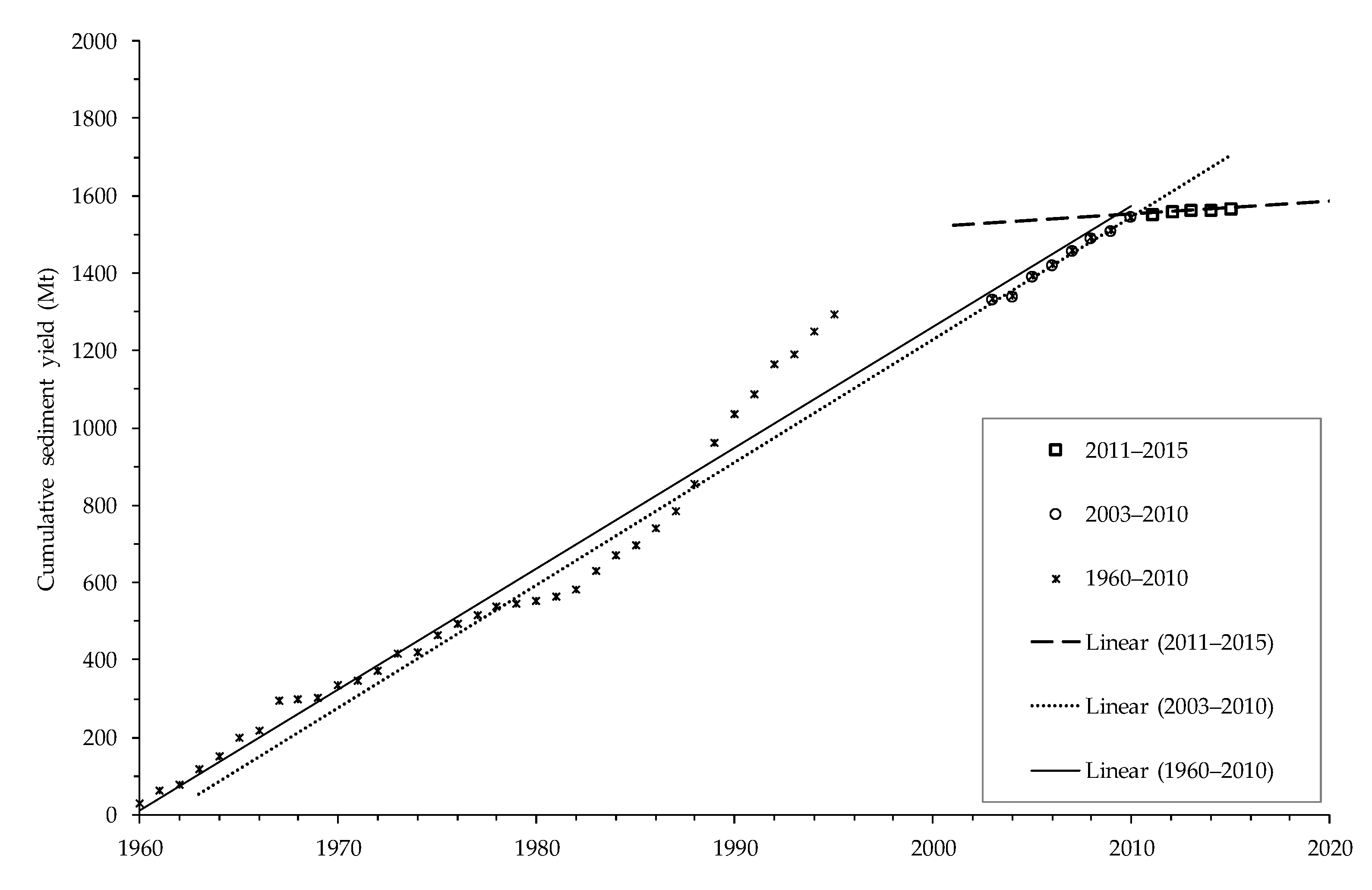
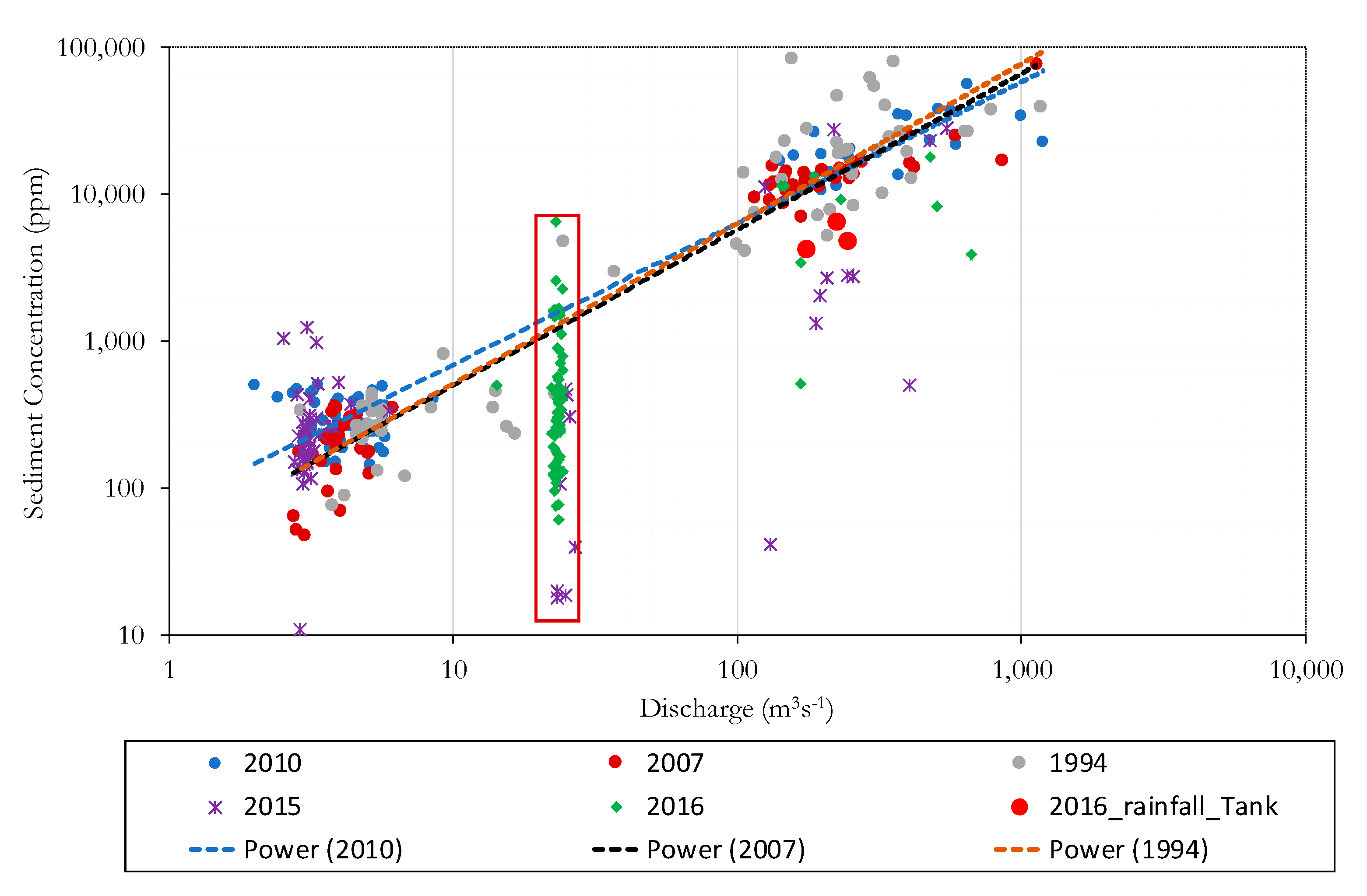
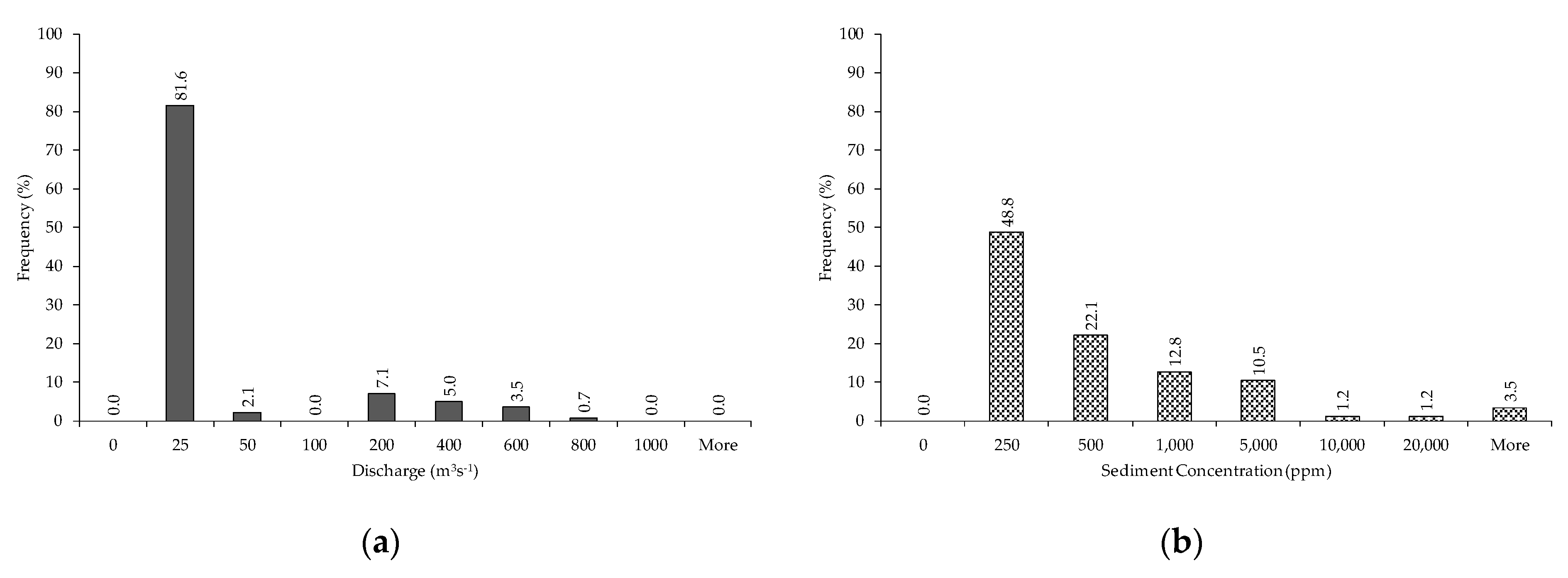
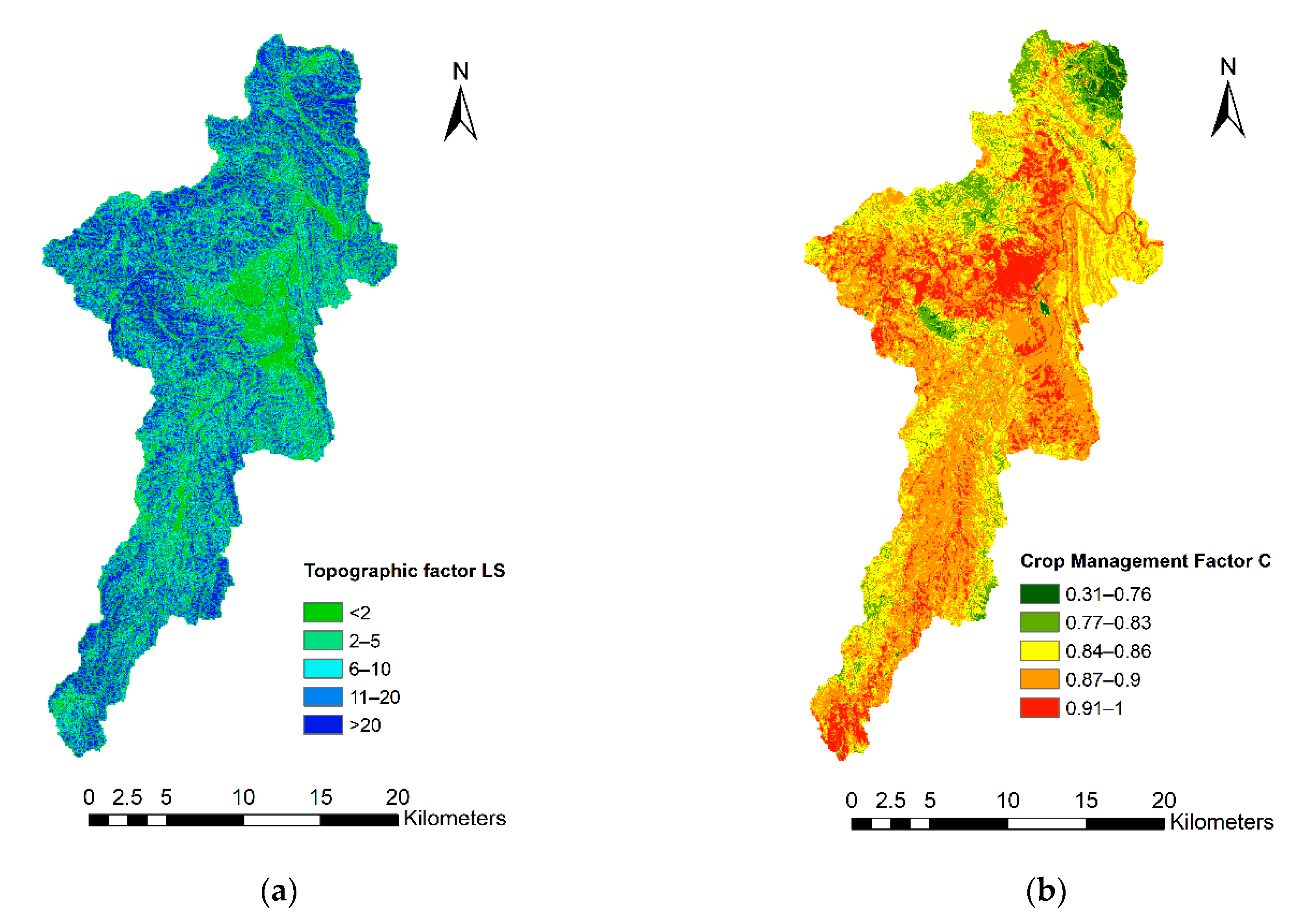
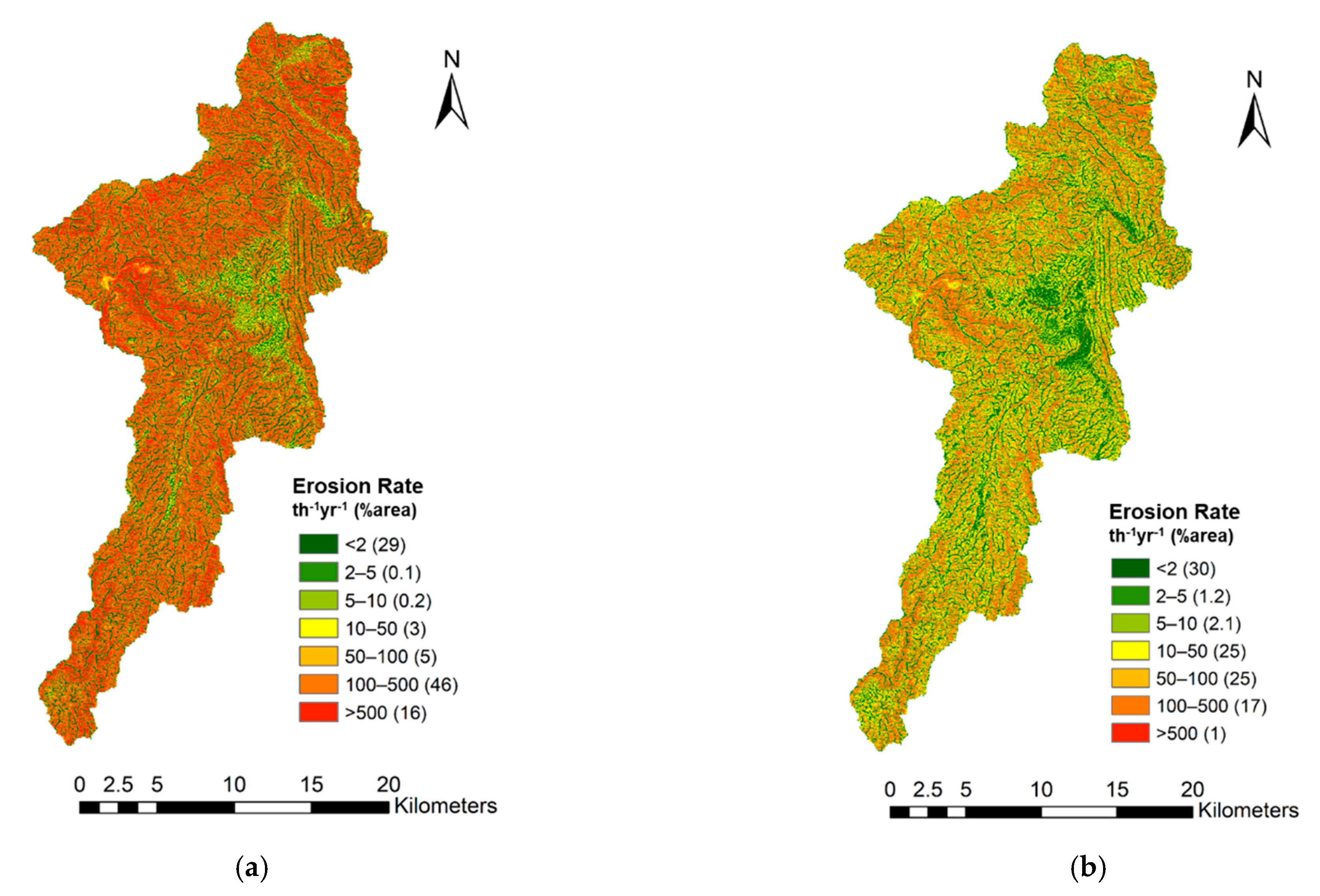
| Serial Number | Equation | Geographic Location | Author(s) |
|---|---|---|---|
| 1 | Morocco and other locations West Africa | Arnoldus (1980) [28] | |
| 2 | |||
| 3 | |||
| 4 | Africa | Roose (1975) [27] | |
| 5 | USA | Fernandez et al. (2003) [29] originally developed by the USDA-ARS | |
| 6 | Turkey | İrvem et al. (2007) [30] | |
| 7 | India | Nakil (2014) [31] |
| Annual Data | Average | |||
|---|---|---|---|---|
| 2014 | 2015 | 2016 | ||
| Rainfall at Tank station (mm) | 226 | 212 | 134 | 191 |
| Rainfall-runoff erosivity factor R (MJ mm ha −1 h −1 yr −1) | ||||
| Arnoldus (1980) [28], West Africa | 38 | 59 | 8 | 35 |
| Arnoldus (1980) [28], Western USA | 37 | 58 | 7 | 34 |
| Arnoldus (1980) [28], Northwest USA | 22 | 25 | 18 | 22 |
| Roose (1975) [27], Africa | 113 | 106 | 67 | 95 |
| Fernandez (2003) [29], USA | 356 | 281 | −128 | 170 |
| İrvem (2007) [30], Turkey | 412 | 531 | 272 | 405 |
| Nakil (2014) [31], India | 1006 | 994 | 934 | 978 |
| The European Soil Data Centre (ESDAC), Global dataset | 538–1300 | 919 | ||
| Erosion Rate (t/ha) | Category 1 | RUSLE | RUSLE with Improved C Factor | Change in the Area with Improved C Factor | |||
|---|---|---|---|---|---|---|---|
| Area (km2) | Proportion (%) | Area (km2) | Area (%) | km2 | Percent | ||
| <2 | Very slight | 133.3 | 29.3 | 135.1 | 29.6 | 1.8 | 1.3 |
| 2–5 | Slight | 0.4 | 0.1 | 5.3 | 1.2 | 4.9 | 1247.8 |
| 5–10 | Moderate | 1.0 | 0.2 | 9.7 | 2.1 | 8.7 | 848.2 |
| 10–50 | High | 15.4 | 3.4 | 111.9 | 24.6 | 96.5 | 625.6 |
| 50–100 | Severe | 21.8 | 4.8 | 114.6 | 25.1 | 92.8 | 425.6 |
| 100–500 | Very severe | 209.6 | 46.1 | 76.0 | 16.7 | −133.6 | −63.7 |
| >500 | Catastrophic | 73.4 | 16.1 | 3.1 | 0.7 | −70.3 | −95.8 |
| Total | 454.9 | 100.0 | 455.6 | 100.0 | |||
Publisher’s Note: MDPI stays neutral with regard to jurisdictional claims in published maps and institutional affiliations. |
© 2021 by the authors. Licensee MDPI, Basel, Switzerland. This article is an open access article distributed under the terms and conditions of the Creative Commons Attribution (CC BY) license (http://creativecommons.org/licenses/by/4.0/).
Share and Cite
Bhatti, M.T.; Ashraf, M.; Anwar, A.A. Soil Erosion and Sediment Load Management Strategies for Sustainable Irrigation in Arid Regions. Sustainability 2021, 13, 3547. https://doi.org/10.3390/su13063547
Bhatti MT, Ashraf M, Anwar AA. Soil Erosion and Sediment Load Management Strategies for Sustainable Irrigation in Arid Regions. Sustainability. 2021; 13(6):3547. https://doi.org/10.3390/su13063547
Chicago/Turabian StyleBhatti, Muhammad Tousif, Muhammad Ashraf, and Arif A. Anwar. 2021. "Soil Erosion and Sediment Load Management Strategies for Sustainable Irrigation in Arid Regions" Sustainability 13, no. 6: 3547. https://doi.org/10.3390/su13063547
APA StyleBhatti, M. T., Ashraf, M., & Anwar, A. A. (2021). Soil Erosion and Sediment Load Management Strategies for Sustainable Irrigation in Arid Regions. Sustainability, 13(6), 3547. https://doi.org/10.3390/su13063547







